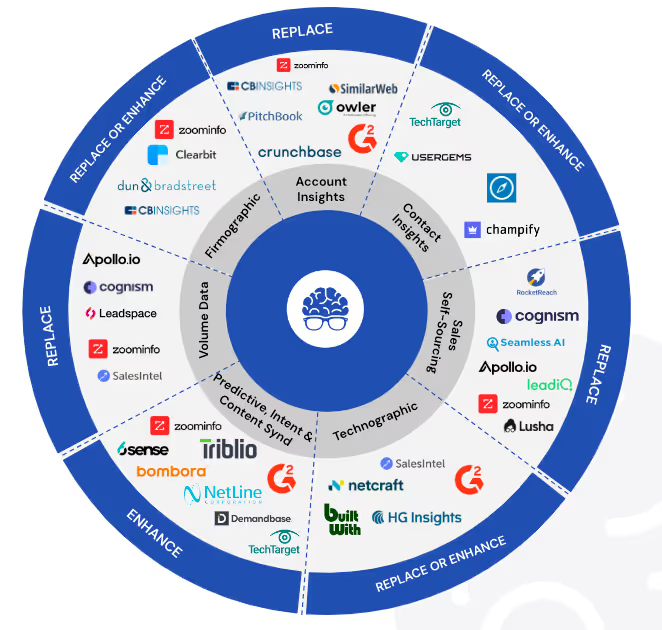Sometimes, despite the best intentions and promising early results, things can go sideways in a deal. I’m not proud of how I handled this particular situation, but I hope that by sharing my story and the lessons I’ve learned, I can help others avoid the same mistakes.
Here’s what happened.
The Backstory
A few months ago, we reconnected with a former user of our "Contact Monitoring" data offering. She manages marketing at a company targeting businesses with fewer than 200 employees, and she was curious to learn about the updates to our real-time data model.
It quickly became clear that our data could be a game-changer for her. After all, our platform is specifically built to provide deep, relevant insights to companies just like hers. She requested an initial sample, and we delivered.
The results were great. She saw an immediate boost in usable contacts and valuable insights.
Here’s the catch: She wasn’t the ultimate decision-maker for data providers. While she was excited about our solution, she’s in marketing, and her company’s RevOps team was the gatekeeper for data decisions.
She tried to get us in front of them, but the RevOps team wasn’t interested in taking the meeting. Despite the roadblock, she found a $5k budget for a formal pilot, so we got creative and delivered 10 targeted campaigns for her team.
The results? Those campaigns directly contributed to $225k in closed deals—50x ROI on the pilot.
You’d think the RevOps team would be excited about that kind of return. Unfortunately, that wasn’t the case. Despite all the success and her advocacy, they still wouldn’t meet with us.
It’s been frustrating for both her and our team.
Where I Went Wrong
In hindsight, I realize there were a few key moments where I should have done things differently. Here are the critical mistakes I made—and what I could have done to avoid this situation entirely.
1. I Didn’t Properly Qualify the Decision-Making Unit (DMU)
This is Sales 101, right? I knew she wasn’t the decision-maker, but I didn’t push hard enough to ensure we had the right players involved from the very beginning. While it’s great to have a strong internal champion, deals fall apart when the real stakeholders aren’t engaged.
What I Should Have Done:From day one, I should have involved the RevOps team or, at the very least, aligned with my marketing contact on a strategy to engage them early. Instead of running the risk of being sidelined later, I could’ve secured buy-in or at least piqued their interest with a targeted proposal.
2. I Let Excitement Override Process
When you see early wins with a prospect, it’s easy to get excited and fast-track the deal. After all, a 50x ROI doesn’t happen every day! But skipping steps—like securing key stakeholder meetings—can come back to bite you.
What I Should Have Done:I should have followed a more structured process, ensuring that each stage of the pilot had checkpoints that involved the decision-makers. Involving them from the beginning might have given them a sense of ownership over the outcome, making it harder for them to ignore the pilot’s success later.
3. I Failed to Build an Irresistible Case for RevOps
While our internal champion was thrilled with the results, I didn’t give RevOps enough reasons to care. I leaned too heavily on the marketing team’s success, assuming that would be enough. The truth is, different departments have different priorities—and I didn’t tailor my value proposition to address RevOps' specific pain points.
What I Should Have Done:I should have crafted a business case specifically for RevOps, showing how our solution could help them achieve their goals. Maybe that’s data accuracy, CRM efficiency, or operational cost savings. The point is, I failed to speak their language, and in doing so, I missed the chance to get them excited about our solution.
What I’ve Learned (and How You Can Avoid My Mistakes)
Here are three key takeaways from my experience that might help you if you’re ever in a similar situation:
1. Qualify, Qualify, Qualify
It can’t be overstated—make sure you’re talking to the right people. Champions are important, but they can’t close the deal for you. Qualify the entire buying committee early and often, and don’t be afraid to push for engagement from the key decision-makers, even if it’s uncomfortable.
2. Stick to a Proven Process
Even if things are going well, it’s important to stick to your sales process. Don’t skip steps, especially when it comes to stakeholder engagement. Those steps are there for a reason—deals are fragile, and cutting corners can cause things to fall apart, even with a 50x ROI.
3. Tailor the Value to Each Stakeholder
Not every department is going to care about the same metrics. What excites marketing might not excite RevOps, and what excites RevOps might not excite leadership. Customize your pitch and your results to each group, and show them how your solution solves their unique problems.
What’s Next?
I’m still navigating this situation, and honestly, I could use your help. What would you have done in my shoes? How can I re-engage RevOps and get them excited about the value we’ve already delivered?
Sales is a constant learning process, and I’m always looking to improve. If you’ve been in a similar situation—or have ideas on how I can turn this around—I’d love to hear your thoughts.
Thanks for reading,
Derek Rahn




